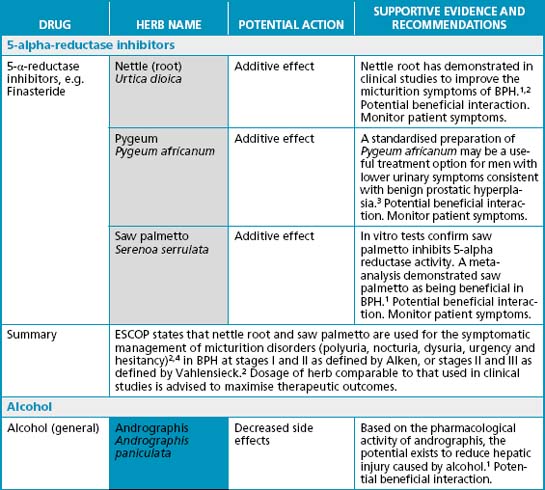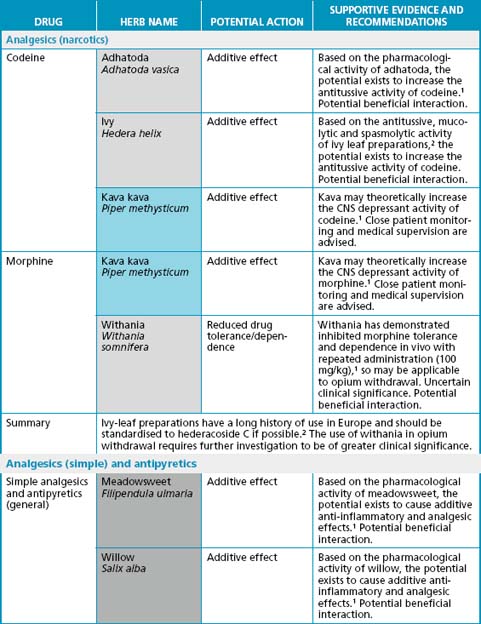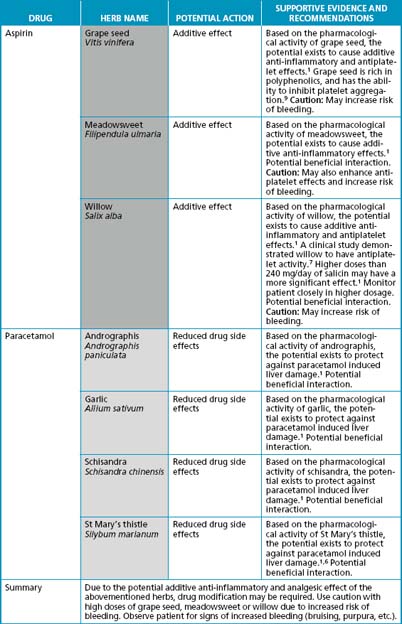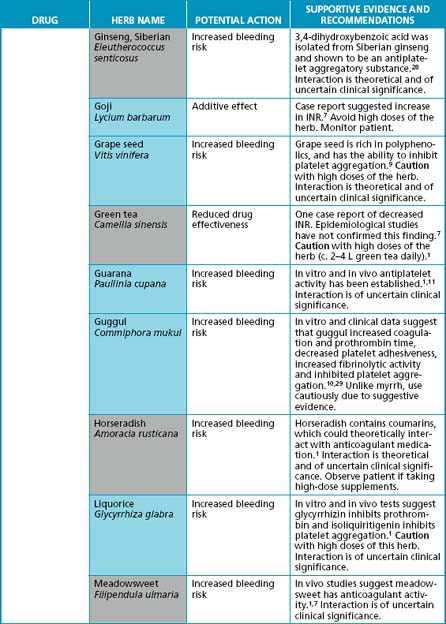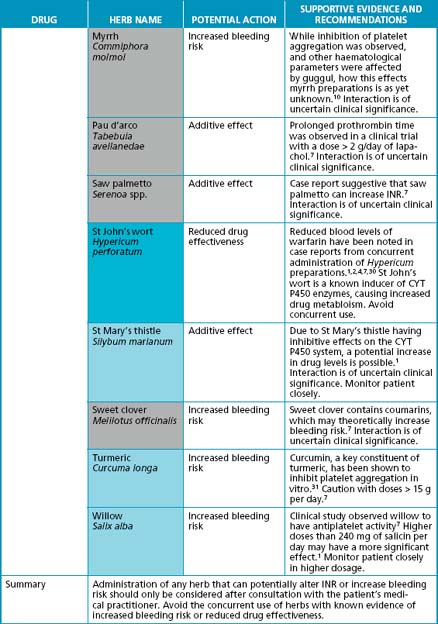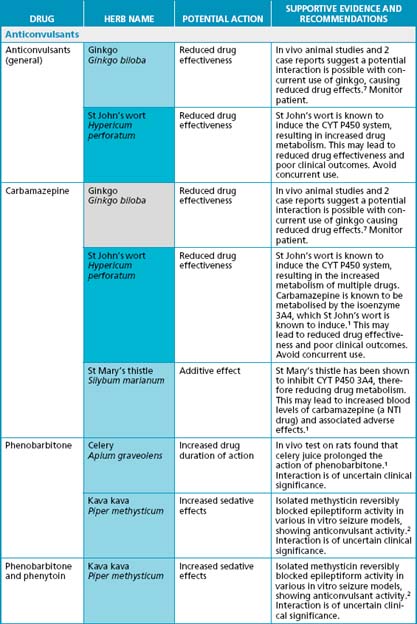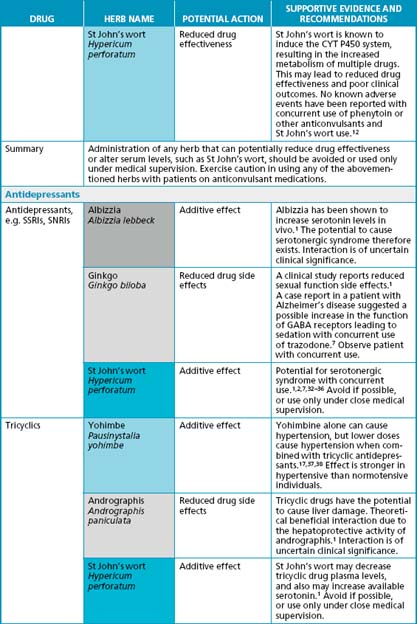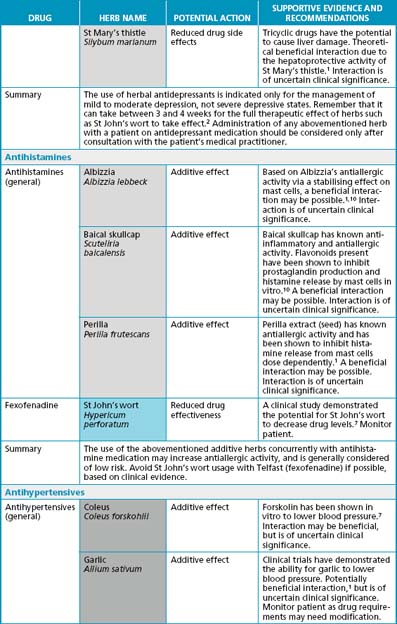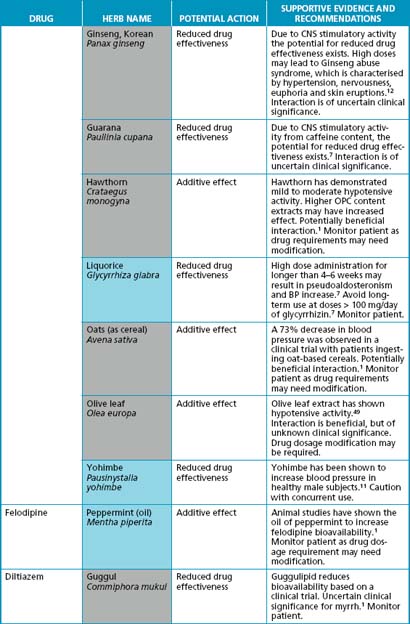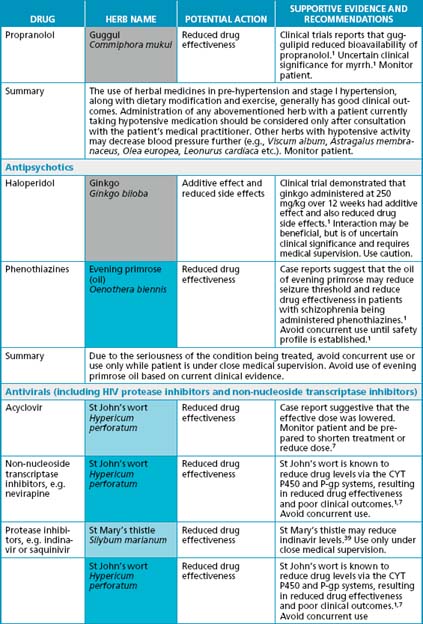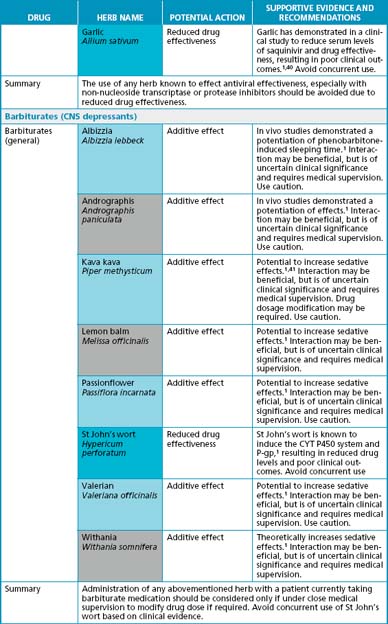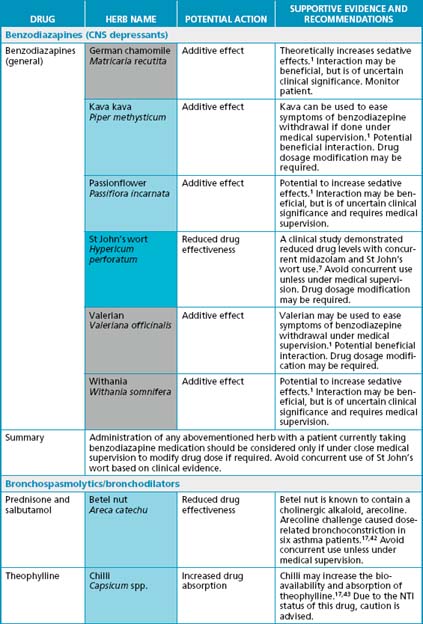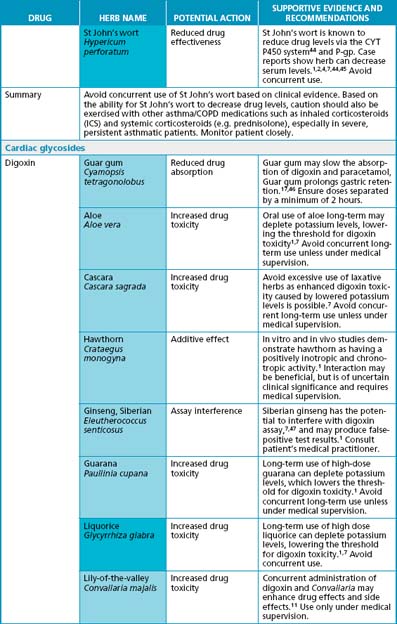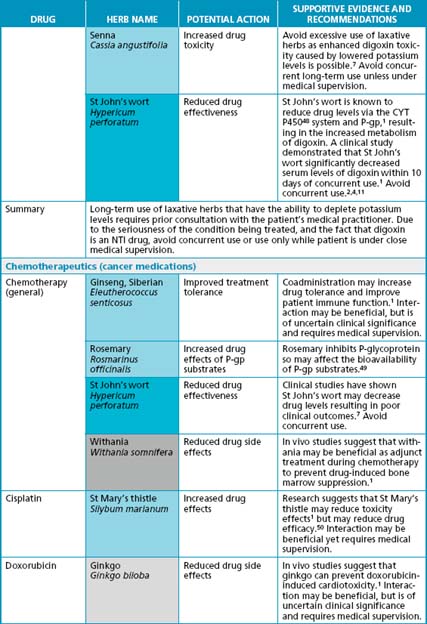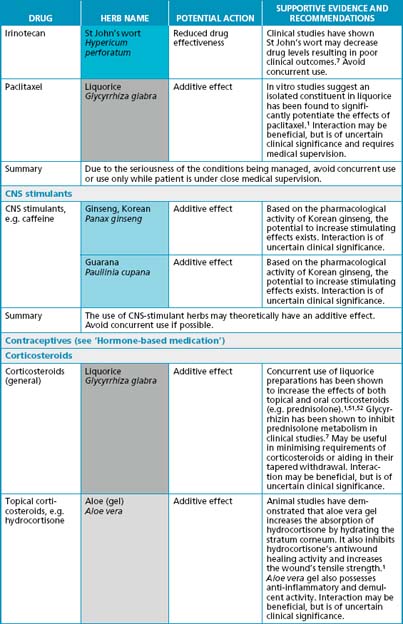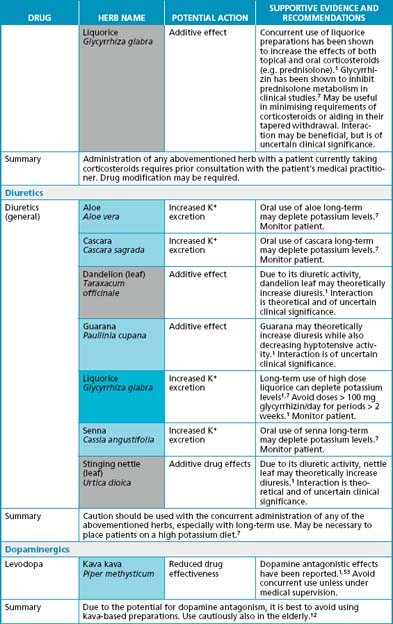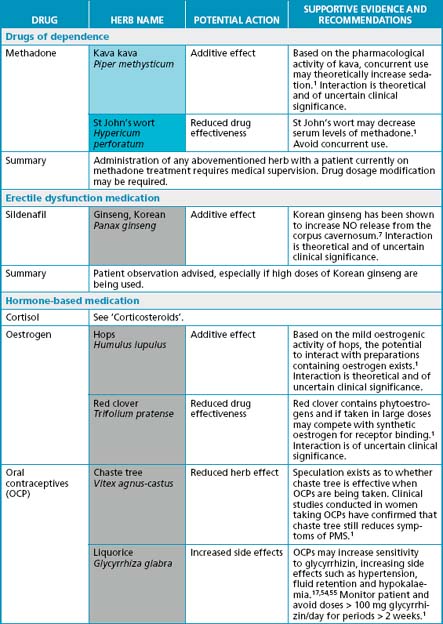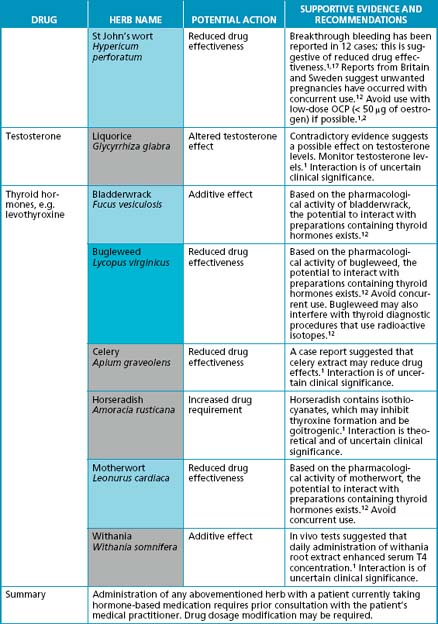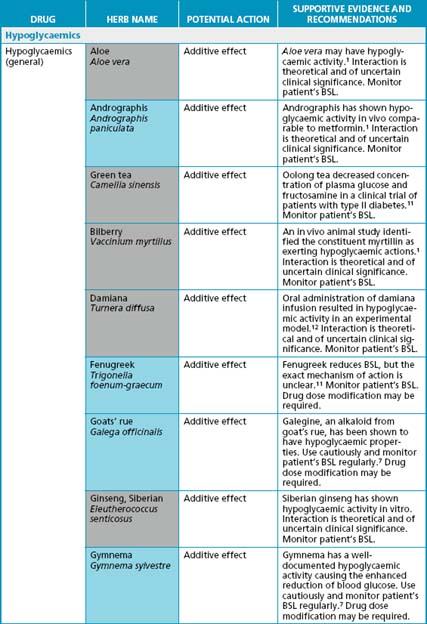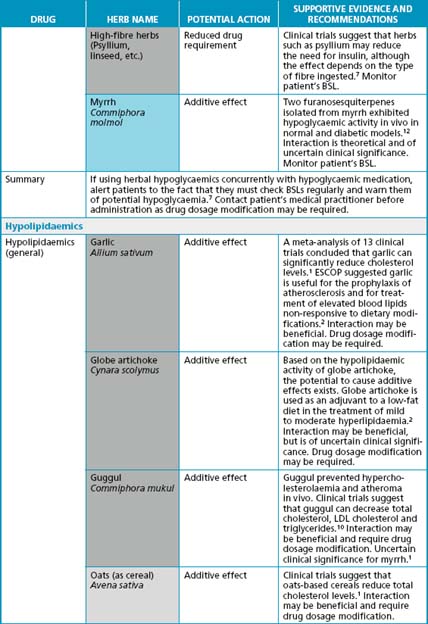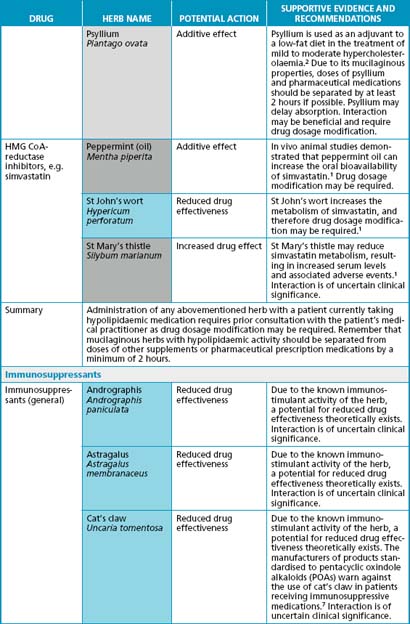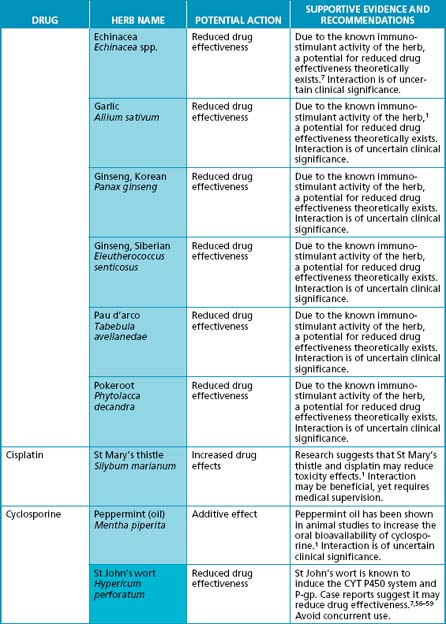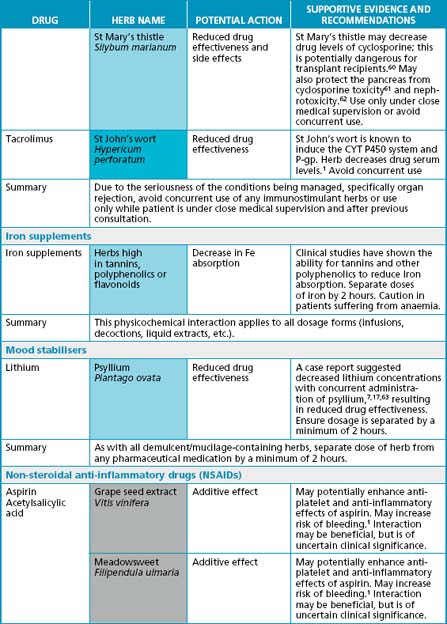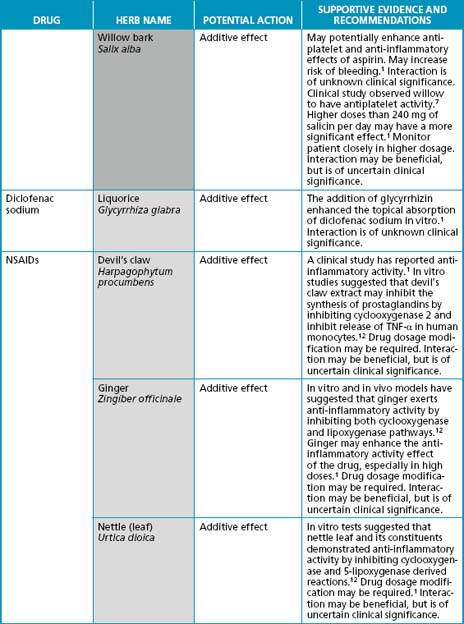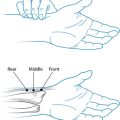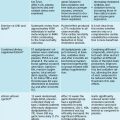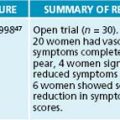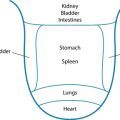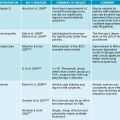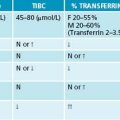Appendix 1 Drug–herb interaction chart
This chart is a designed as a quick reference only. Further investigation may be required before making a clinical decision. This chart has been compiled using evidence-based texts, journal articles and monographs to give a current summary of known drug–herb interactions. Where applicable, supportive evidence has been referenced to allow for further investigation. The chart has been designed using a colour-coded system to highlight the different levels of supportive evidence and clinical significance. The table uses drug class as major headings for ease of information retrieval, and provides a summary of important or clinically relevant information at the end of each heading.
 |
Implies a serious interaction with known potential to cause harm or decreased drug effectiveness. Avoid concurrent use. |
 |
Use caution. Interactions have some supportive evidence. Concurrent medical supervision or avoidance is advised. |
 |
Observe. Interactions are largely theoretical and of unknown clinical significance and/or minimal supportive evidence. |
 |
Implies a potential beneficial interaction. Interactions are largely theoretical and of unknown clinical significance and/or supportive evidence. |
1. Braun L., Cohen M. Herbs and natural supplements: an evidence-based guide. Marrickville: Elsevier Australia; 2005.
2. ESCOP Monographs, 2nd edn. Exeter: European Scientific Cooperative on Phytotherapy; 2003.
3. Wilt T., et al. Pygeum africanum for benign prostatic hyperplasia. Cochrane Database Syst Rev. 1, 2002. CD001044
4. WHO monographs on selected medicinal plants, Vol 2. Geneva: World Health Organization; 2003.
5. Lee F., et al. Effects of Panax ginseng on blood alcohol clearance in man. Clin Exp Pharmacol Physiol. 1987;14:543-546.
6. Muriel P., et al. Silymarin protects against paracetamol-induced lipid peroxidation and liver damage. J Appl Toxicol. 1992;12:439-442.
7. Mills S., Bone K. The essential guide to herbal safety. St Louis: Churchill Livingstone; 2005. 684
8. Siegers C.P. Influence of dithiocarb, (+)-catechin and silybine on halothane hepatotoxicity in the hypoxic rat model. Acta Pharm Toxicol. 1983;53:125-129.
9. Shanmuganayagam D., et al. Grape seed and grape skin extracts elicit a greater antiplatelet effect when used in combination than when used individually in dogs and humans. J Nutr. 2002;132(12):3592-3598.
10. Bone K. Clinical applications of Ayurvedic and Chinese herbs: monographs for the Western herbal practitioner. Phytotherapy Professional Development. In Warwick. Phytotherapy Press; 1996.
11. Gruenwald J., et al. Physicians desk reference for herbal medicines, 3rd edn. Montvale: Thomson PDR; 2004. 988
12. Bone K. A clinical guide to blending liquid herbs: herbal formulations for the individual patient. St Louis: Churchill Livingstone; 2003. 531
13. Chan K., et al. The effects of danshen (Salvia miltiorrhiza) on warfarin pharmacodynamics and pharmacokinetics of warfarin enatiomers in rats. J Pharm Pharmacol. 1995;47:402-406.
14. Tam L., et al. Warfarin interactions with Chinese Traditional medicines: danshen and methyl salicylate medicated oil. Austr N Z J Med. 1995;25:257.
15. Yu C., et al. Chinese Herbs and warfarin potentiation by danshen. J Inter Med. 1997;241:337-339.
16. Page R., Lawrence J.D. Potentiation of warfarin by dong quai. Pharmacotherapy. 1999;19:870-876.
17. Fugh-Berman A. Herb–drug interactions. Lancet. 2000;355:134-137.
18. Rose K., et al. Spontaneous spinal epidural hematoma with associated platelet dysfunction from excessive garlic ingestion: a case report. Neurosurgery. 1990;26(5):880-882.
19. German K., et al. Garlic and the risk of TRUP bleeding. Br J Urol. 1995;76(4):518.
20. Burnham E. Garlic as a possible risk for postoperative bleeding. Plast Reconstr Surg. 1995;95(1):213.
21. WHO monographs on selected medicinal plants, Vol 1. Geneva: World Health Organization; 1999.
22. Valli G., Giardina E- G. Benefits, adverse effects and drug interactions of herbal therapies with cardiovascular effects. J Am Coll Cardiol. 2002;39(7):1083-1095.
23. Lamant V., et al. Inhibition of the metabolism of platelet activating factor by three specific antagonists from Ginkgo biloba. Biochem Pharmacol. 1987;36(27):49-52.
24. Rowin J., Lewis S.L. Spontaneous bilateral subdural hematomas associated with chronic Ginkgo biloba ingestion. Neurology. 1996;46:1775-1776.
25. Vale S. Subarachnoid haemorrhage associated with Ginkgo biloba. Lancet. 1998;352:36.
26. Matthews M. Association of Ginkgo biloba with intracerebral hemorrhage. Neurology. 1998;50:1933.
27. Coxeter P.D., et al. Herb–drug interactions: an evidence based approach. Curr Med Chem. 2004;11:1513-1525.
28. Yun-Choi, et al. Potential inhibitors of platelet aggregation from plant sources, III. J Nat Prod. 1987;50(6):1059-1064.
29. Satyavati G.V. Gum guggul (Commiphora mukul): the success story of an ancient insight leading to a modern discovery. Indian J Med Res. 1988;87:327-335.
30. Blumenthal M., et al. The ABC clinical guide to herbs, 1st edn. Austin: American Botanical Council; 2003.
31. Mills S., Bone K. Principles and practice of phytotherapy. London: Churchill Livingstone; 2000. 602
32. Barbenel D.M., et al. Mania in a patient receiving testosterone replacement postorchidectomy taking St John’s wort and sertraline. J Psychopharmacol. 2000;14(1):84-86.
33. Beckman S.E., et al. Consumer use of St John’s wort: a survey on effectiveness, safety, and tolerability. Pharmacotherapy. 2000;20(5):568-574.
34. Dannawi M. Possible serotonin syndrome after combination of buspirone and St John’s wort. J Psychopharmacol. 2002;16(4):401.
35. Lantz M.S. St John’s wort and antidepressant drug interactions in the elderly. J Geriatr Psychiatry Neurol. 1999;12(1):7-10.
36. Parker V., et al. Adverse reactions to St John’s wort. Can J Psychiatry. 2001;46(1):77-79.
37. De Smet P. Yohimbe alkaloids, in adverse effects of herbal drugs. In: De Smet PAGM. Borago officinalis. In De Smet PAGM, Keller K, Hansel R, Chandler RF, eds. Adverse effects of herbal drugs, vol II. Berlin: Springer-Verlag, 1997:181–206.
38. Lacombiez L., et al. Effect of yohimbine on blood pressure in patients with depression and orthostatic hypertension induced by clomipramine. Clin Pharmacol Ther. 1989;45:241-251.
39. Piscitelli S.C., et al. Effect of milk thistle on the pharmacokinetics of indinavir in healthy volunteers. Pharmacotherapy. 2002;22(5):551-556.
40. Piscitelli S.C., et al. The effect of garlic supplements on the pharmacokinetics of saquinavir. Clin Infect Dis. 2002;34(2):234-238.
41. Anke J., Ramzan I. Pharmacokinetic and pharmacodynamic drug interactions with kava (Piper methysticum Forst.). J Ethnopharmacol. 2004;93:153-160.
42. Taylor R., et al. Betel-nut chewing and asthma. Lancet. 1992;339:1134-1136.
43. Bouraoui A., et al. Influence de l’alimentation épicée et piquante sur l’absorption de la théophylline. Therapie. 1986;41:467-471.
44. Nebel A., et al. Potential metabolic interaction between St John’s wort and theophylline. Ann Pharmacother. 1999;33:502.
45. Sarkar M.A., et al. Characterization of human liver cytochromes P-450 involved in theophylline metabolism. Drug Metab Dispos. 1992;20(1):31-37.
46. De Smet P., D’Arcy P.F. Drug interactions with herbal and other non-toxic remedies. In: Mechanism of drug interactions. Berlin: Springer-Verlag; 1996.
47. McRae S. Elevated serum digoxin levels in a patient taking digoxin and Siberian ginseng. CMAJ. 1996;155:293-295.
48. Johne A., et al. Pharmacokinetic interaction of digoxin with an herbal extract from St John’s wort (Hypericum perforatum).. Clin Pharmacol Ther. 1999;66:338-345.
49. Braun L., Cohen M. Herbs and natural supplements: an evidence-based guide, 2nd edn. Marrickville: Elsevier; 2007.
50. Gaedeke J., et al. Cisplatin nephrotoxicity and protection by silibinin. Nephrol Dial Transplant. 1996;11(1):55-62.
51. Chen M-F., et al. Effect of oral administration of glycyrrhizin on the pharmacokinetics of prednisolone. Endocrinol Jpn. 1991;38:167-175.
52. Chen M-F., et al. Effect of glycyrrhizin on the pharmacokinetics of prednisolone following low dosage of prednisolone hemisuccinate. Endocrinol Jpn. 1990;37:331-341.
53. Schelosky L., et al. Kava and dopamine antagonism. J Neurol Neurosurg Psychiatry. 1995;58:639-640.
54. Bernardi M., et al. Effects of prolonged graded doses of licorice by healthy volunteers. Life Sci. 1994;55:864-872.
55. De Klerk G., et al. Hypokalaemia and hypertension associated with use of liqourice flavoured chewing gum. BMJ. 1997;314:731-732.
56. Kronbach T., et al. Cyclosporine metabolism in human liver: identification of a cytochrome P-450III gene family as the major cyclosporine-metabolizing enzyme explains interactions of cyclosporine with other drugs. Clin Pharmacol Ther. 1988;43(6):630-635.
57. Barone G.W., et al. Herbal supplements: a potential for drug interactions in transplant recipients. Transplantation. 2001;71:239-241.
58. Ruschitzka F., et al. Acute heart transplant rejection due to Saint John’s wort. Lancet. 2000;355(9203):548-549.
59. Bauer S., et al. Alterations in cyclosporin A pharmacokinetics and metabolism during treatment with St John’s wort in renal transplant patients. Br J Clin Pharmacol. 2003;55:203-211.
60. Pal D., Mitra A.K. MDR-and CYP3A4-mediated drug-herbal interactions. Life Sci. 2006;78:2131-2145.
61. von Schonfeld J., et al. Silibinin, a plant extract with antioxidant and membrane stabilizing properties, protects exocrine pancreas from cyclosporine A toxicity. Cell Mol Life Sci. 1997;53:917-920.
62. Zima T., et al. The effect of silibinin on experimental cyclosporine nephrotoxicity. Ren Fail. 1998;20(13):471-479.
63. Perlman B. Interaction between lithium salts and ipsaghula husk. Lancet. 1990;335:416.

